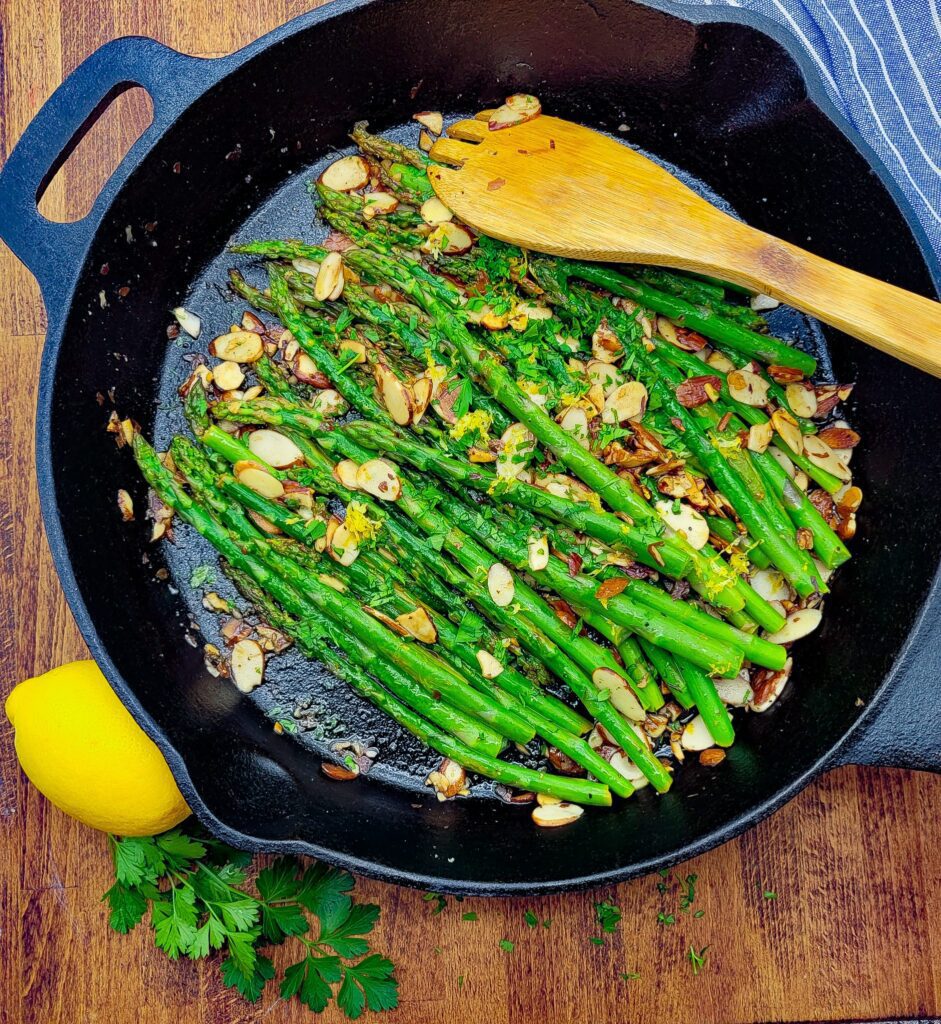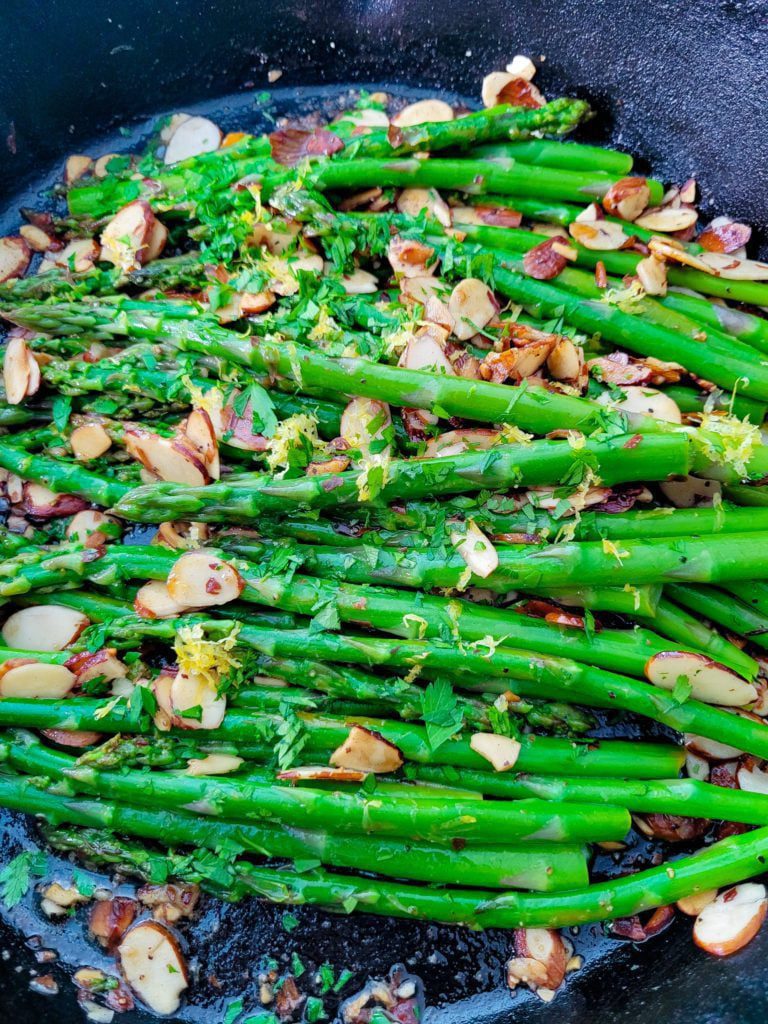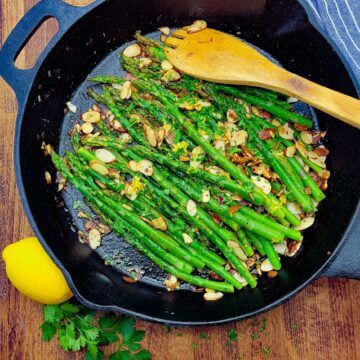Spring has sprung in Northwest Florida and my springtime food cravings are kicking in! In the springtime, I gravitate toward fresh seasonal fruits and vegetables. Actually, that's a lie. I gravitate toward fresh seasonal produce year-round. Summer is the time for stone fruit salad and caprese pasta salad with fresh summer tomatoes. In the fall, I love warm apple cider and autumn roasted vegetables. Winter calls for hearty mashed potatoes and shepherd's pie. In the springtime, I love fresh asparagus and lemon. Today, I will share with you my favorite asparagus recipe - my Easy Sauteed Asparagus Amandine.
This side dish is especially delicious served alongside oven baked salmon or sun-dried tomato pasta salad.
Please note, this post contains affiliate links which means I will receive a small commission on the sale of these items at no cost to you.

A Versatile Superfood
Asparagus is a staple in my household. Not only is it super quick and easy to prepare in a variety of different ways, but it is a very nutritious vegetable. One might even call it a superfood. According to Healthline, asparagus has a lot of nutrients, especially folate and vitamins A, C, and K. It is also rich in antioxidants and can improve digestive and heart health.
In addition to being a super healthy spring vegetable, it is very versatile. Asparagus can be cooked using several different cooking methods.
How To Clean And Trim Asparagus
Before you cook asparagus, it is important to wash the spears under cold water. Most of the stalk is edible, but the bottom part can be pretty woody in texture (read = icky to eat), especially in thick stalks. Fear not! There is a super easy way to remove the woody part of the asparagus. You don't even need a knife for this!
- Take each end of one asparagus stalk in each hand.
- Gently bend the stalk outward away from your body.
- The stalk will break in the perfect spot. Voila! The woody textured bottom is removed and the remaining stalk is ready to be cooked!
Methods For Cooking
You may be wondering how to cook asparagus. This recipe post is for sauteed asparagus. The awesome thing about this vegetable is that it can be cooked in many different ways. Here is a breakdown:
Steamed
To steam asparagus on the stove, bring about a cup of water to a boil in a saucepan fitted with a steamer basket. Place the stalks into the steamer basket, cover the saucepan with a lid. Steam the asparagus until they are bright green and crisp, yet tender - about 5 minutes.
To steam asparagus in a microwave, place stalks in a large microwave-safe bowl with a lid. Add enough water to cover the bottom of the bowl. Microwave on high, covered, for 5 minutes. Be careful when removing the dish from the microwave - it will be hot!
Oven Roasted
To oven roast asparagus, place the stalks on a sheet pan. Drizzle with about 2 tbsp. of olive oil. Sprinkle the asparagus with ½ tsp. salt and ½ tsp. coarsely ground black pepper. Roast in a 425°F/220°C oven for 12-15 minutes, based on how thick the stalks are. The finished product: crispy and tender asparagus spears that are a party for your mouth (as my dad would say)!
Grilled
To grill asparagus, drizzle the stalks with about 2 tbsp. olive oil. Sprinkle the stalks with about ½ tsp. of salt - but don't add pepper! Pepper burns on a hot grill, so it is better to sprinkle a pinch of pepper on the asparagus after the grilling process. Bring your grill or grill pan to high heat and grill your asparagus stalks for about 3-4 minutes, or until they have a nice char and a tender texture.
Jazz It Up
Before we get to the centerpiece of this post, sauteed asparagus, I wanted to touch on some ideas for making your asparagus side dish more exciting.
There are a few ways you can jazz up simple steamed, oven roasted, or grilled asparagus:
- After cooking, you could sprinkle them with coarsely chopped fresh herbs. I recommend tarragon, dill, flat leaf parsley, rosemary, or thyme. These herbs are a delicious complement to asparagus.
- You could also mix ½ cup of mayonnaise, 1 tsp. of dijon mustard, the juice of ½ of a lemon, and 2 tbsp. chopped fresh dill for an excellent aioli in which to dip your cooked spears.

Sauteed Asparagus Amandine
Although this post is more of a "how to cook asparagus" post, the recipe below is for sauteed asparagus. That being said, you can make the amandine sauce and pour it on asparagus that has been prepared using any of the methods above.
When you are sauteeing asparagus, it is important to first blanch it. In fact, many chefs blanch asparagus before cooking it using any of the methods mentioned in this post (with the exception of steaming). I don't actually feel it is necessary to blanch in the methods above, but it is important when you are sauteeing.
How Do You Blanch Vegetables?
Blanching is a method used by cooks that entails plunging vegetables into boiling water for a short time and then placing the vegetables into an ice bath (to stop the cooking process). Blanching allows vegetables to retain their nutrients while simultaneously removing bitterness and enhancing their color. You aren't trying to cook the vegetables fully, the goal is to allow the vegetables to retain their integrity during the sauteeing (or grilling/roasting) process.
It is especially important to blanch vegetables before freezing them. The blanching process sanitizes vegetables by removing any bacteria or organisms that may be present in or on the vegetable. So, if you are thinking about freezing uncooked vegetables (carrots, broccoli, etc.), be sure to blanch them first!
Amandine Sauce
This sauteed asparagus recipe features a bright amandine sauce. What is amandine? Amandine refers to a dish that is garnished with toasted almonds.
In this recipe, sliced almonds are toasted with melted butter and lemon juice. The blanched asparagus is then tossed in this almond sauce and served with a sprinkling of chopped flat leaf parsley. I love this recipe because it is an elegant, sophisticated side dish but it could not be easier to prepare!
Just a side note: although I prefer to use the French term, "amandine," for this recipe, it can also be spelled, "almondine." Both are correct, both are interchangeable. In the US and Canada, "almondine" is more widely used. It comes down to preference, and mine is "amandine." What is yours?

Easy Sauteed Asparagus Amandine
Ingredients
- 1 pound asparagus trimmed (see method above)
- ¼ cup unsalted butter
- ½ cup almonds sliced
- 1 large lemon juiced and zested
- ¼ cup flat leaf parsley chopped
- ¼ tsp. salt
- ¼ tsp. coarsely ground pepper
Instructions
Blanch the Asparagus
- First, prepare an ice bath - fill a large bowl with ice and water.
- Bring a saucepan filled with water to a rolling boil.
- Place asparagus spears into boiling water.
- Quick boil asparagus. For thin stalks, boil for 30-45 seconds. For thicker stalks, boil for 1 minute.
- Remove asparagus and transport immediately to prepared ice bath for 1 minute.
- Remove asparagus from ice bath and place to the side on a sheet pan lined with paper towels.
Toast the Almonds
- Place almonds into a skillet set over medium high heat.
- Toast almonds, stirring occasionally, until they turn slightly brown and they have a nutty aroma, about 5 minutes.
Prepare the Amandine Sauce
- Once the almonds are toasted, reduce heat to medium low. Add butter to the skillet and melt.
- When butter is melted, add the juice of 1 lemon, ¼ tsp. salt, ¼ tsp. pepper.
- Drop blanched asparagus into the skillet and cook in the sauce until asparagus is tender, about 4-5 minutes.
- Garnish with chopped parsley and lemon zest. Serve immediately.


Leave a Reply